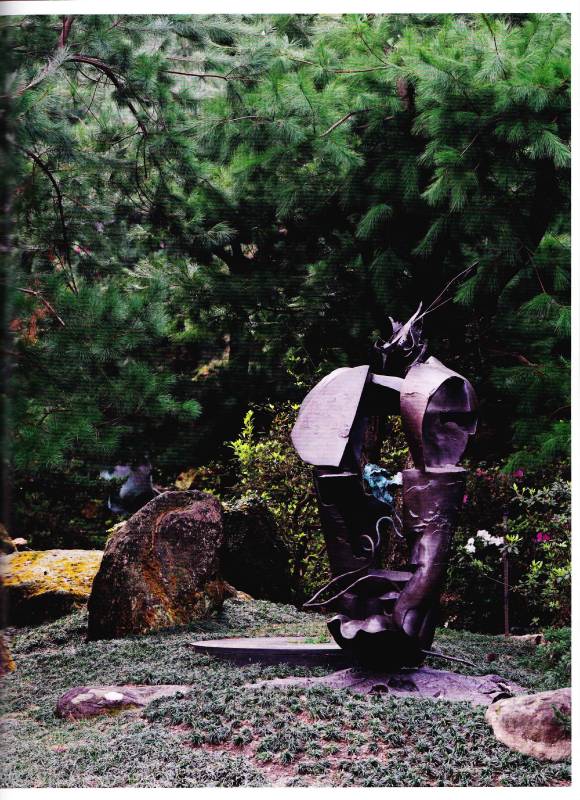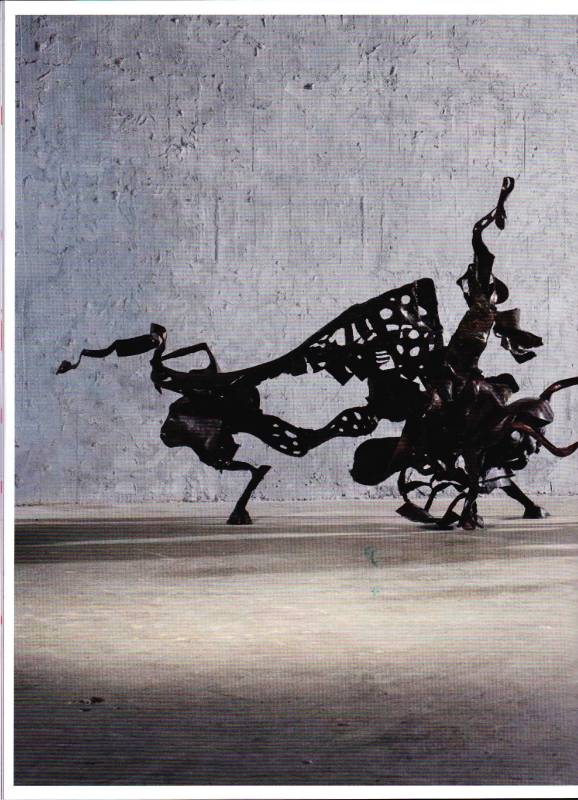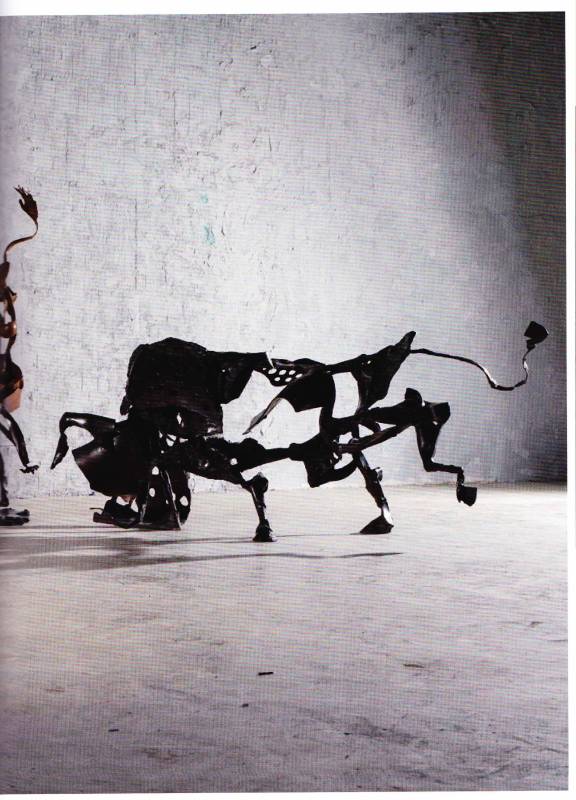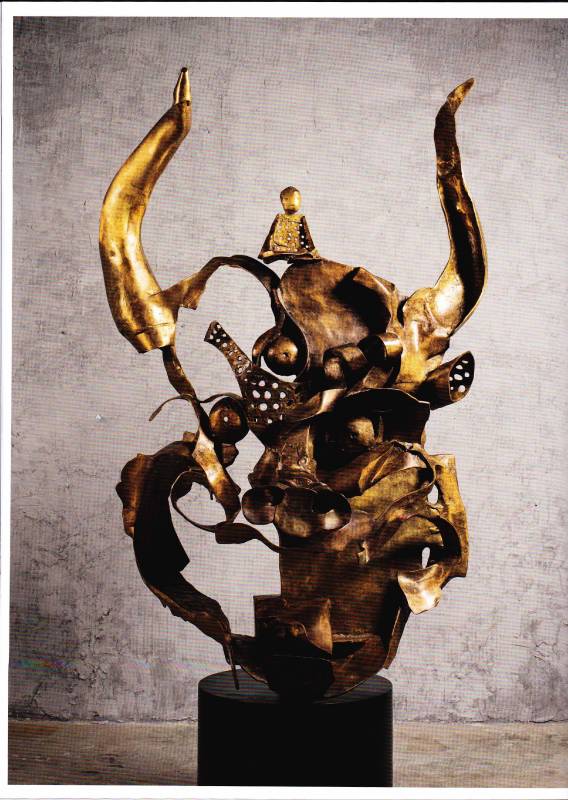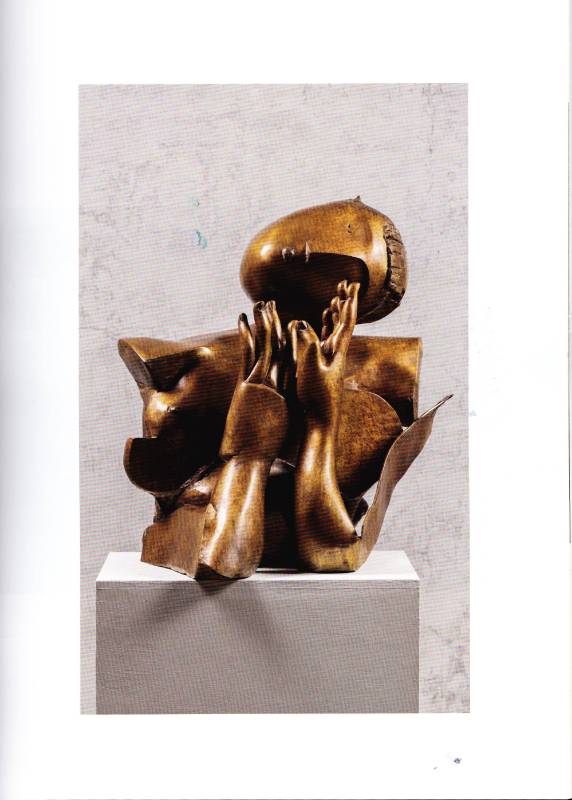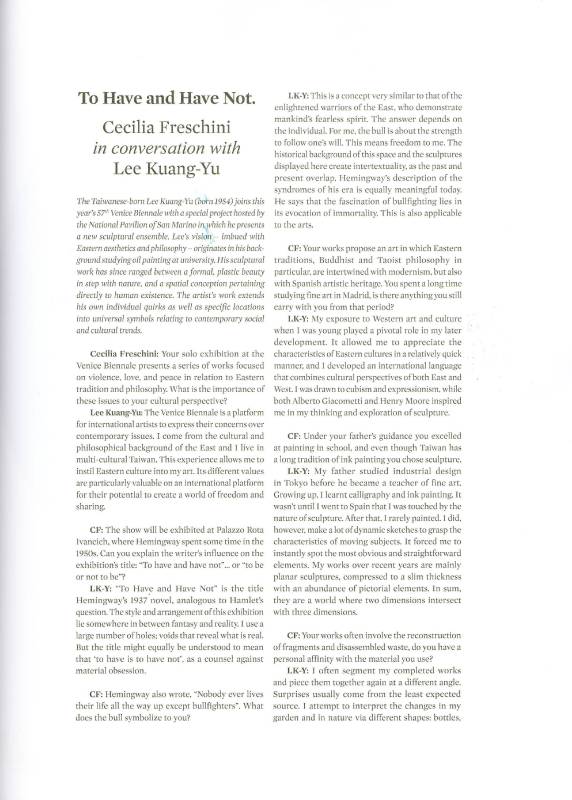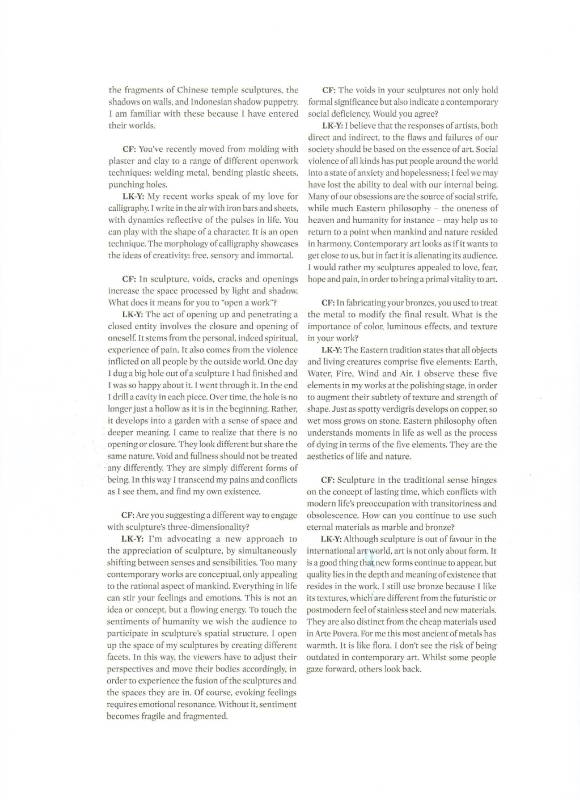采泥藝術:【Flash Art 2017.05 To Have and Have Not】Cecilia Freschini in Conversation with Lee Kuang-Yu
2017-05-25|撰文者:Fresh Art Cecilia Freschini
Interview to Lee Kuang-Yu by Cecilia Freschini
[Flash Art, May ’17]
(Cecilia Freschini,以下簡稱CF)
CF:您有30多年的創作生涯,您的作品跨越了文化界限,向我們展示了一個藝術創作者如何將東方傳統,特別是佛道哲學,與現代主義以及西班牙的藝術特質結合起來。您在馬德里度過了很長時間,毫無疑問在您早期創作中積極吸收了西方現代主義的精華。對您來說,您是否認為這段海外經歷是某種藝術上的洗禮?
至少我認為,這段時期代表了您人生中的一大轉折點,現在您身上是否還有某些和那個時期相關的東西?這段經歷如何反映在您的作品中?
A:在我年青時代,接受西方藝術文化之洗禮,對我往後的發展扮演很重要的角色,在比較學上,增進對東方的文化特質更快速的理解。尤其在往後的藝術發展過程中,產生了一個東方文化觀的國際語言,這是一個很大的幫助。另一方面,我當時特別被立體主義,表現主義所吸引,立體派的雕塑,以及像賈科梅蒂,亨利•摩爾等人的作品都啟發我對雕塑空間的思考與探索。
CF:您在很早上中學的時候就開始學畫,而且台灣有長期的水墨畫傳統,但是您卻選擇了雕塑科,是什麼原因呢?您現在還素描或畫畫嗎?
藝術評論家瓦薩里曾說,“雕塑和油畫是姐妹藝術,來自同一個父親即素描,他們同時誕生,不分先後。”這句話跟您的藝術觀是否有共同之處?
A:我父親曾赴日本東京學習“工業設計”,後來擔任小學美術教師,耳濡目染之下,我從小學開始即學習傳統水墨畫及書法,直到大專時,我想學習立體的藝術,而選擇了雕塑。那時,我同時也做水墨,油畫,雕塑等,一直混在一起工作。我到西班牙後,才真正被雕塑的特質所感動,就很少畫畫了。但在西班牙時期,做了大量的素描,尤其是動態素描,在移動的對象中,必須快速掌握對象的“特質”。被迫學會了剎那間就看到對象最簡單明顯的特質在哪。這對往後雕塑形象的掌握起了很大的助益,就是一根線條就標出那主要的命題,你將養成將簡單的事物可以演繹出一個複雜結構的能力。這或許就是你說的造型藝術本源自同一個“父親”。在近年來,我的主要作品壓縮厚度成一個接近平面的雕塑,作品充滿繪畫性元素,形成一個平面與立體相互穿梭作品。
CF:在您的藝術研究某個階段,您對現實主義不太滿意,並接收了西方現代主義打破禁錮的影響。立體主義宣言中譬如“解構”,“集成”,“重組”等詞彙很快成為您的基本觀念。在您的作品中,解構起到了創新的作用,並且自發的產生了對拆解的廢品和碎片的重組,您能就此談談您的觀點嗎?
A: 我對於“解構”,“集成”,“現成廢料”的再發現,在知識上,很早就知道了,但是從內心真正的感應,起源自傳統工藝器物的啟發。建築,廟宇之浮雕,它的“散點透視”重構出一個超越現實的多重觀點。這種看似不合理的結構方式,如果一開始就不合理,那麼爾後所有的不合理都變成合理與合情。如此,解放了對現實描繪的約束。“沒有什麼不可以”,“俯拾皆得,不假諸鄰”,生活周邊的東西,令你興起很大的感動,你發現了它,那不是高深的形而上學可比擬,不是思想,概念,而是一種流動的能量。
我常常將已完成的作品,將之切割分開,再從不同的角度集成。它常常出現你意想不到的驚喜,超越自己的經驗慣性,此即“緣思不到,一片靈明,廓落無依,十方通暢“之偈語。在西班牙留學時,我的教授托萊多教我如何造型之理,後來加上佛法之學,更進一步在實踐中了悟其趣,時時感受到所有現象之變化都在實踐中“自生”的秘密。
CF:再創作中,塑造和重組的動作與日常生活是相關的,有藝術家的個人氣質在裡面。
您所使用的材料和技法是不是和您的個人生活緊密相關,而且參與到您的生活中去?
A:我的工作室裡,有許多的器物是我創作的來源,譬如說,建築裡牆面的花窗呈現一個穿透的空間,各式的瓶子,傳統中國廟宇的雕刻片段,牆面倒影及印尼皮影等,以及我的花園,大自然之變化,我只是將這些以我的造型方式去詮釋它。在金屬焊接工作室,堆滿了廢料,它們的形態非常意外,我熟悉它們,進入了它們的世界。
CF:您的近期作品(從2013年到2016年)呈現出一種新的結構趨向。在技法方面,您從使用石膏和泥去模塑形狀,變成使用一些很不同的技法,比如焊接金屬,彎折塑料片,開洞等等。在形式層面,您達到了一種完美的片狀結構。更進一步,這些作品整合了一種成熟的“開放式”技法。您能就此談談嗎?
A、在最近的作品裡,呈現出中國書法藝術的偏好,以鐵條,鐵片代替毛筆在空中書寫,它的動勢顯現當下的生命脈動,就像一個字你可以任意去造型它,它是開放性的技法,在類似書寫的形態裡,可以讀到創作的觀念:自由,感官世界,以及靈魂不朽。
CF:您最近雕塑的趨向是打開之前關閉的空間,去除多餘的提及,盡可能多的創造“孔洞”。我覺得,雕塑就像人生,我們必須刪除一些不必要的東西才能看見內部。在雕塑的“空”的概念方面,裂縫和鏤空增加了空間,並帶來光與影的變幻。
對你而言,“打開雕塑作品”意味著什麼?
A:對於一個關閉的實體,將之打開,穿透,也意味著自己的關閉與打開,它源自於自己對痛苦的經驗,來自精神方面自我的痛苦,也來自這個世界給予人們的暴力。有一天,我在已完成的實體雕塑上挖了一個大洞,頓時心生歡喜!我穿透過去了後來我在每件作品都會挖洞,經驗久了,那孔洞已不是當初的洞,而成為一個有空間感的,有深層涵義的“花園”。我漸漸覺得,沒有打開,也沒有關閉,它們表象不同,但本質都一樣,不應該將“空”與“有”區別對待,它們都是存在的不同形式。就這樣我穿透了我的痛苦與矛盾的表象,找到了我的存在。
CF:孔洞本身可以有和實體同樣多的形式意涵。在打開內部空間的過程中,您也創造了更多的“面”,也就是更多空間變化,以及更多觀看作品的視點。從而觀眾可以不局限於雕塑外表面,也可以深層穿透作品。您是否在建議一種觀看雕塑的新方式?請談一談您的觀點。
A:我認為觀看雕塑要有新的方式,最好能不斷的將理性和感性同時調動。當代太多雕塑是概念化的,只能作用於人的理性層面,為了調動人的感性,我希望觀眾能夠參與到雕塑的空間構造中。我將雕塑空間打開,創造更多的面,這樣觀眾在觀看中必須跟隨雕塑轉移視點,以及移動他們的身體,這會形成雕塑作品與他們所處的空間融合的感受。當然,調動人的感性還需要一個重要的基礎,就是情感共鳴,如果少了它,那麼感性必定是殘缺無力。
CF:不同於亨利摩爾的神秘的“空洞”,或賈科梅蒂作品的虛無主義感,您的“空”不僅具有藝術價值,而且可以視為對當代社會的缺陷或失敗的一種回應。您覺得藝術可以反映和揭示現實世界的缺失嗎?如何反映?
您認為在我們的社會中有什麼東西缺失了?也許您覺得與東方文化相比較,西方文化有某種缺陷?
您在作品中所創作的“空”是不是可以平衡那些我們這些人心裡都有的“裂痕”?以您的個人生存經驗來舉例?
A:我認為藝術家對當代社會的缺陷或失敗的回應,無論是直接的還是間接的,都應該基於藝術的本質。當代社會的各種暴力讓全世界人們感到無奈與焦慮,我覺得缺失的東西可能是我們如何去面對自己的內心,實際上人們心中的很多執念,正是當代社會爭端的來源。東方文化的很多觀點如天人合一思想,幫助我們回到一個人與自然和諧共處的原點,反思人在宇宙的時間空間中的位置,及人的價值所在,也許可以修補一些人在社會中不斷被物化而造成內心裂痕。當代藝術表面表面上與人們很靠近,但實際上作品與觀眾很疏離,我更願意從人性的根本,比如愛與恐懼,希望與痛苦等等這些感官層面,用一種觀眾都可理解的雕塑形態,給藝術帶來一些原始的生命力。
CF:在您的製作銅雕的過程中,您常使用一些特殊方法使自然的元素呈現在雕塑上,修飾最終效果。這些自然的顏色,光影和肌理在您的作品中有什麼重要性?
A:按照東方傳統觀點,構成人及事物的元素有五大元素,地,水,火,風,空,在我的作品中,我依循這五大元素,在最後的修飾效果階段,為增強作品的肌理變化及造型的張力,使它得到結實,溫潤,活力,動勢的豐富生命元素,比如讓銅長出斑駁的銅綠,讓石頭長出潮濕的青苔。這些元素廣泛見於東方的生命觀點,不管是生命存活的時候還是死亡凋零的過程,均以地,水,火,風,空來闡述,它是一套自然生命觀的美學。
CF:您在第57屆威尼斯雙年展上的特別企劃大型個展,展示了一系列關注暴力,愛與和平的作品,並以東方文化傳統和哲學來呈現您的思考。威尼斯雙年展一個特殊場合,
它使藝術家置身於大的國際背景中衡量自己,並在一個更廣闊,更清晰的上下文中的反思自己的角色。從您的文化立場上來說,您覺得威尼斯雙年展有什麼意義?您覺得您的文化與西方經驗和思考方式會很不同嗎?
A:威尼斯雙年展是國際藝術家發表作品的展出平台,它關懷藝術在當代所關注的問題,及鼓勵藝術新的潛能發展。我具有東方文化和哲學傳統的背景,生活在多元文化的台灣,這種生活經驗促使我將自己對東方文化的理解注入藝術作品。在國際化的平台上,傳統文化的某些不同價值,在文化,宗教及思考方式上的差異,更顯出其可貴性。對我個人而言,我深信人的善意與潛能,希望能創造出與人共享的自由世界。
CF:這個展覽在“海明威之家”(Palazzo Rota Ivancich)舉辦,主要作品受到海明威小說的啟發,特別是他對鬥牛的熱愛鬥牛象徵著人和野獸的鬥爭。今天,我們的世界又充滿戰爭,恐怖與暴力,這些事越來越戲劇性而且離我們越來越近了,你認為“戰鬥”是一種榮譽嗎?
引用海明威的名言,“除非你是鬥牛士,否則沒有誰的生活只進不退”,這個好像聽起來跟東方文化有些遙遠?在你看來,我們必須要面對的“牛”是什麼?
A:不只是“戰鬥”,即使是“和平”這樣的名詞,前面都要加上“智慧”這兩個字,不然就會形成暴力。藝術家非常敏感於各種二元對立的現象,因此很難片面的說我們今天的現實世界“戰鬥”是一種榮譽還是相反的。
海明威的名言,“除非你是鬥牛士,否則沒有誰的生活只進不退”,這也非常貼切東方文化中所說的“覺悟勇士”。“勇士”(warrior)這個詞表達的是一種人類無畏無懼的精神,但勇氣首先應當真誠的面對自己的本來面貌,並擁有以慈愛善待他人的勇氣。牛象徵什麼?該留給每個人回答。對於我而言象徵的是“隨欲寶牛“,隨欲,就是隨從自己的願望,永不匱乏;寶牛,代表著勇猛有力,對我來說,這意味著自由的境界海明威作為美國”迷惘的一代“代表作家,他所描寫的時代癥候在我們今天同樣具有意義。海明威還有一句話說,鬥牛“能使人陶醉,能讓人有不朽之感,能使他入迷”,這句話同樣適用於藝術。
A:“To Have and Have Not”取自海明威的一部小說標題,它的意思可以說接近“To Be or Not to Be”,探討“有”和“沒有”之間的東西這個展覽展出的作品,包括布展的風格,都有點接近現實與幻覺之間,但我覺得在這個臨界點所體現出來的精神存在和靈魂不朽才是最真實的。這也有點像我的雕塑風格,我大量使用孔洞,這些不存在的,虛空的空間,也是在反思什麼才是實在的。從反面講,這個標題也可以理解為,“有”既是“沒有”,這樣理解有一點幻滅感,告訴人們對物質不要太執著。
CF:從您在汐止的寧靜安謐的雕塑花園,到威尼斯市中心一個前貴族的府邸,這在展示空間上很大的變化。藝術作品往往能改變其所展示的空間,見證我們的時代。特別當藝術作品能為空間帶來一種特定背景的烙印時,實際上用更多的記憶層面豐富了它。因此,在一個特定場所佈置雕塑需要特別小心的研究雕塑與環境之間的關係。
在我看來,您的作品的創造性過程,與您生活的環境緊密相關。我想像,每天早晨當您帶著想法在花園中散步和傾聽時,您的雕塑就在這種環境中誕生了。在您的雕塑花園中,作品是與您親手種下的樹木擺在一起,在一個開放的空間。我在思考,當把您的作品從開放的空間轉入室內空間時會發生什麼。這次您的作品被放在一個歷史空間,在一個如此不同的語境下會對您的作品產生什麼影響?他們還是帶有原來的感受,意義和感染力嗎?請談談你的觀點。
A:我的雕塑確實是在我的花園,在我與自然的朝夕相處,對雲,山,四季景物的變化中領悟與創作出來的。因此在我的花園裡看到這些雕塑能夠感受到一種藝術與自然的和諧一體,它們呈現自然形態的變化,並且通過孔洞與周圍景色相互映襯,如同中國園林的設計,模糊了人為與自然的界限。這次在威尼斯的古老建築內展出,它曾是一處貴族宅邸,建於16世紀,1950年代海明威曾往來於此,確實如你所說,這個空間所具有的特定背景與放置其中的雕塑產生了互文,形成了過去的與當代的歷史空間的折疊。我們在布展時也試圖與特定空間產生對話,並沒有將它完全改造成美術館的“白盒子”,而是特別保留一些存留的家居佈置,比如窗簾,壁爐,梳妝鏡等,根據這些空間本來具有的用途,曾經的起居室,臥室,有一些不同的安排,例如在二樓的窗前放置尊吸煙的人像,有點像是場景复現或追憶,希望雕塑本身的感染力給這個已經無人居住的空間帶來生機,反之這個特定空間帶給雕塑更多歷史層面的意涵。
CF:最後我想問,在當今國際藝術背景下,您對雕塑藝術這門學科有什麼看法?您可能知道有人質疑在21世紀藝術是否還存在。在我看來,這個問題是有意義的,因為我們無疑能觀察到很明顯和根本性的變化。也許有些人持實用主義的看法,認為雕塑材料如大理石和銅應該被更容易獲得、更簡單的材料代替,特別是對於未成名的年輕藝術家而言,當然您不是這樣。為什麼現在還要使用銅?似乎您想要逆流而上,您甚至想使您的作品看起來更“舊”更“古老”,您個人認為,在當代藝術創作中,是否有不合時宜的風險?
A:在當今國際藝術的背景下,雕塑藝術示微了,然而藝術並不在於形式,任何新的技法或形式不斷出現是件好事,品質才是創作者的深度與存在的意義。雕塑的特質“雕刻性“及其相關的物質性,不易被別的藝術取代,它存在的價值也不因時空的轉變而改變。我至今做雕塑還用傳統材料”銅“,因為我喜歡銅帶來的質感,它不同於不銹鋼,新科技材料所帶來的後現代或未來感,也不同於類似“貧窮藝術”所使用的廉價材料,對我而言,銅這種人類三千多年前最早發現的古老金屬元素是具有溫度的,像自然界的植物一樣。我不認為在當代藝術創作中有不合時宜的風險,當有些人望向未來的時候,總要有些人也望向過去。
*******************************************
QUESTIONS:
1. CF: Mr. Lee Kuang-Yu, thirty years of creative career… you have a long artistic experience to share with us! Your works had crossed cultural boundaries representing an artistic marker in which Oriental traditions, as Buddhist and Taoist philosophy, intertwines with modernism, but also with Spanish artistic heritage. In deed, you had spent a long time in Madrid, studying Western sculptural technique and theory at Real Academia de Bellas Artes de San Fernando and Universidad Complutense. Without any doubts, you had actively absorbed the essence of Western modernism at the begging of your art carrier: do you consider this overseas experience a sort of artistic baptism?
At least, I think, this moment had represent one of the biggest turning points in your life, is there anything you still carry with you now related to that period?
How this experience has been reflecting in your work?
2. CF: Although under your father’s influence, you excelled at painting at the junior high school and even though Taiwan has a long tradition on ink painting… you choose the sculpture department, what had bring you there?
Do you still sketch or paint?
“I say, therefore, that sculpture and painting are actually sisters, born from the same father who is the drawing, they have been delivery together at the same time; no one precedes the other…”(Giorgio Vasari), how closed is this quote to your artistic conception?
3. CF: At a certain point in your artistic research, you felt not content with realism; the influenced by Western modernism contributed to break through the confinement. Terms such as “deconstruct”, "assemble" and "reconstruct”, which owns to Cubism manifesto, have been quickly become essential parts in your poetic. Nevertheless, in your work deconstruction take the meaning of innovation that flows spontaneously into a reconstruction of dissembled wastes and fragments…
4. CF: The action of building and assembling approaches and correlates with daily living, involving the artist personal sphere. A set of forms that capture value and meaning from the relationship that the artist is able to attribute, are you agree?
Does the materials you use have somehow an affinity and participate into your personal life journey?
5. CF: Your recent works (from 2013 to 2016) revealed a new structural tendency. In terms of techniques, you have been changing from using plaster and clay for molding shapes to using a range of different techniques, such as welding metal sheets together, bending plastic sheets, puncturing holes, etc. In terms of form, you have embodied the culmination of the sheet structure. Moreover, these works integrated a mature openwork techniques…
6. CF: The tendency in your latest sculpture is to opened up the previously enclosed space and removed excessive volume as much as possible to create more "holes." I would say, sculpting is like living, we must remove the unnecessary and pull the more, to see inside.
In sculpture the concept of void, cracks and openings increases the space that is further processed by a play of light and shadow.
What means for you to “open a work”?
7. CF: A hole can itself have as much shape-meanings as a solid mass. In the process of open up the internal space you practically created more "facets," more transformation of space but also more perspectives to look at his work. In this way the audience is not limited to the external surface, but viewers can deeply penetrate the work: are you suggesting a different way to watch at a sculpture, able to go forward the three-dimensionality?
8. CF: Unlike, for instance, the Moore mystic void or the nihilistic sense proposed by Giacometti, your void is not only about an artistic value, but it also regards to a contemporary social deficiency and failure. Is this correct?
Can art represent that missing part of the reality'? If so, how?
What do you think is missing in our society? Perhaps you can feel that there is a default in the Western culture compare to the Oriental one?
What kind of “void” belongs to you? Is the void you create in your sculpture somehow able to balance the cracks, which we all have, in your personal being?
9. CF: During the work in progress of your bronze sculptures, you used to take action on the natural substance by applying special treatments in order modify the final result. Which importance do have the colors, light effects and texture in your work?
10. CF: Your special solo exhibition during the 57th Venice Biennale presents a series of works focused on the expression of the violence, love and peace in relation with the oriental culture tradition and philosophy. Venice Biennale is a special occasion to measure oneself against an international landscape, and become award of one’s role within a wider, more articulated and endlessly fascinating context. Which implications have these issues in your cultural perspective? Are they so different from a Western experience and way of thinking?
11. CF: This show will be placed in Palazzo Rota Ivancich, which is known as the Hemingway House and the main works in the exhibition are inspired by his novels, especially his passion for bull-fight. This practice symbolizes the struggle between man and beasts. Nowadays, we are surrounded by wars, things are becoming more and more dramatic and closed to us, do you think fight is indeed an honor?
Quoting Hemingway “Nobody ever lives their life all the way up except bullfighters”; this sound so far from an oriental though, is it? From your point of view, which is the bull we should face with?
12. Yet again from Hemingway comes the title inspiration for this latest: “To have and have not”… or “to be or not to be”?
13. CF: From your peaceful sculpture garden upon the Xizhi mountains in Taiwan to an exquisite example of a noble and luxurious residence in the heart of the city of Venice... Wow! Is a big change, isn’t?
An artwork, when able to transform the place where it is placed, can witness our contemporary time. When the artwork is able to imprint a certain context then it does enrich it with additional memory layers.
So, the placement of a sculpture in a particular place always requires careful and extensive studies on the relationship surrounding sculptural space.
In my opinion your works come from a creative process purely correspondent and connected with the surrounding space where you live. . I image your sculptures born in the garden that you love and nurture every morning with your thoughts while walking and while listening to it. Your works may also contain all of this. They are conceived in you sculpture garden in an open space, together with the trees that you used to cure and plant by your self. I wonder, what happen to this creation once they are decontextualized from this openair environment and presented within an interior space?
This time your work will be presented inside an historical palace, and I guess this is not the first time this happen; within a so different context what happen to them? Are they maintaining the some sense, meaning, and influence?
14. CF: I would ask now your opinion regards to the sculptural discipline inside the international art context of today. You may know that there is critical strand wonders if this artistic discipline actually still exists in the XXI century. From my point of view this question is worthy. We can undoubtedly observe an obvious and substantial change. Maybe it based on a utilitarian and pragmatic speech as the costs of the sculpture, from which depends the replacement of materials such as marble and bronze, in favor of the more handy and more easily workable materials, for a matter of the initial cost of the manufactured article, not more sustainable by a young artist not yet claimed. This is certainly not your case…
Why still using material like bronze todays?
In addition to the upon mentioned economic matter, I would say that we are witnessing a change in thinking of sculptural artwork. The traditional sense of the sculpture hinges on the concept of lasting time, which is probably in conflict with the modern lifestyle based on ephemeral, obsolescence and transitory… How do you think this can match with the use of almost eternal materials like marble and bronze?
it seems you're going upstream, you even like to "age" your artwork... from your point of view do you believe there is a risk of anachronism in the practice of making contemporary art?

